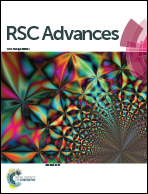Ferrocene catalysed heteroarylation of BODIPy and reaction mechanism studies by EPR and DFT methods†
Abstract
The C–H heteroarylations of BODIPy using heteroaryl diazoniumtetrafluoroborate and ferrocene (Fc) as catalysts were carried out. Mono and di heteroaryl BODIPy derivatives (1–8) were obtained in a cost-effective way. This method gives easy access to 4-pyridyl substituted BODIPy (7, 8), which is useful for synthesizing water soluble derivatives for biological applications. The pathway for this reaction was studied by carrying out spin cross-over experiments using electron paramagnetic resonance (EPR) techniques. A strong EPR signal was obtained in the presence of ferrocene and heteroaryldiazonium salt, which indicates the formation of radicals during the initial steps of the reaction. In addition, we have also performed computational investigations on different steps of the reaction to elucidate the role of ferrocene as a radical initiator in this reaction.


 Please wait while we load your content...
Please wait while we load your content...